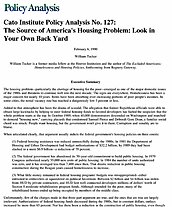Added to that atmosphere has been the drama of scandal. The allegation that former Republican officials were able to obtain large kickbacks by helping to steer federal housing funds to favored developers has fueled the suspicion that the whole problem starts at the top. In October 1989, when 40,000 demonstrators descended on Washington and marched to demand “housing now,” carrying placards that condemned Samuel Pierce and Deborah Gore Dean, a familiar social chord was struck: People want housing, but the government won’t give it to them. Corruption and venality are to blame.
When articulated clearly, that argument usually indicts the federal government’s housing policies on three counts:

